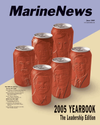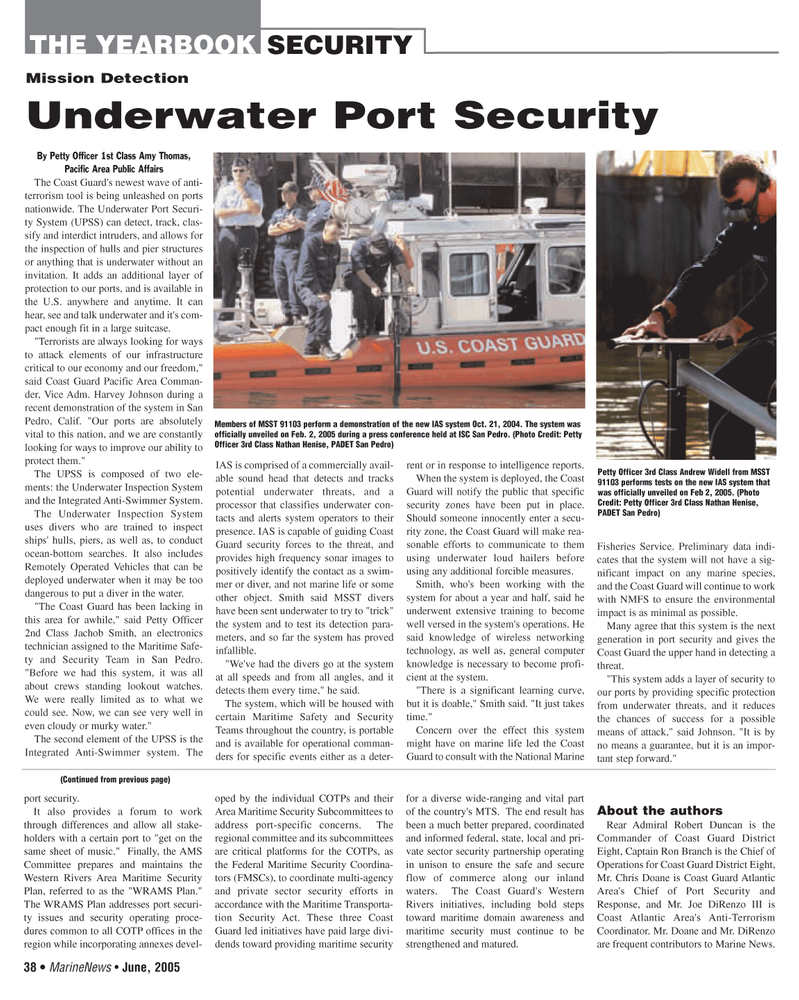
Page 38: of Marine News Magazine (June 2005)
Read this page in Pdf, Flash or Html5 edition of June 2005 Marine News Magazine
port security.
It also provides a forum to work through differences and allow all stake- holders with a certain port to "get on the same sheet of music." Finally, the AMS
Committee prepares and maintains the
Western Rivers Area Maritime Security
Plan, referred to as the "WRAMS Plan."
The WRAMS Plan addresses port securi- ty issues and security operating proce- dures common to all COTP offices in the region while incorporating annexes devel- oped by the individual COTPs and their
Area Maritime Security Subcommittees to address port-specific concerns. The regional committee and its subcommittees are critical platforms for the COTPs, as the Federal Maritime Security Coordina- tors (FMSCs), to coordinate multi-agency and private sector security efforts in accordance with the Maritime Transporta- tion Security Act. These three Coast
Guard led initiatives have paid large divi- dends toward providing maritime security for a diverse wide-ranging and vital part of the country's MTS. The end result has been a much better prepared, coordinated and informed federal, state, local and pri- vate sector security partnership operating in unison to ensure the safe and secure flow of commerce along our inland waters. The Coast Guard's Western
Rivers initiatives, including bold steps toward maritime domain awareness and maritime security must continue to be strengthened and matured.
About the authors
Rear Admiral Robert Duncan is the
Commander of Coast Guard District
Eight, Captain Ron Branch is the Chief of
Operations for Coast Guard District Eight,
Mr. Chris Doane is Coast Guard Atlantic
Area's Chief of Port Security and
Response, and Mr. Joe DiRenzo III is
Coast Atlantic Area's Anti-Terrorism
Coordinator. Mr. Doane and Mr. DiRenzo are frequent contributors to Marine News. 38 • MarineNews • June, 2005
By Petty Officer 1st Class Amy Thomas,
Pacific Area Public Affairs
The Coast Guard's newest wave of anti- terrorism tool is being unleashed on ports nationwide. The Underwater Port Securi- ty System (UPSS) can detect, track, clas- sify and interdict intruders, and allows for the inspection of hulls and pier structures or anything that is underwater without an invitation. It adds an additional layer of protection to our ports, and is available in the U.S. anywhere and anytime. It can hear, see and talk underwater and it's com- pact enough fit in a large suitcase. "Terrorists are always looking for ways to attack elements of our infrastructure critical to our economy and our freedom," said Coast Guard Pacific Area Comman- der, Vice Adm. Harvey Johnson during a recent demonstration of the system in San
Pedro, Calif. "Our ports are absolutely vital to this nation, and we are constantly looking for ways to improve our ability to protect them."
The UPSS is composed of two ele- ments: the Underwater Inspection System and the Integrated Anti-Swimmer System.
The Underwater Inspection System uses divers who are trained to inspect ships' hulls, piers, as well as, to conduct ocean-bottom searches. It also includes
Remotely Operated Vehicles that can be deployed underwater when it may be too dangerous to put a diver in the water. "The Coast Guard has been lacking in this area for awhile," said Petty Officer 2nd Class Jachob Smith, an electronics technician assigned to the Maritime Safe- ty and Security Team in San Pedro. "Before we had this system, it was all about crews standing lookout watches.
We were really limited as to what we could see. Now, we can see very well in even cloudy or murky water."
The second element of the UPSS is the
Integrated Anti-Swimmer system. The
IAS is comprised of a commercially avail- able sound head that detects and tracks potential underwater threats, and a processor that classifies underwater con- tacts and alerts system operators to their presence. IAS is capable of guiding Coast
Guard security forces to the threat, and provides high frequency sonar images to positively identify the contact as a swim- mer or diver, and not marine life or some other object. Smith said MSST divers have been sent underwater to try to "trick" the system and to test its detection para- meters, and so far the system has proved infallible. "We've had the divers go at the system at all speeds and from all angles, and it detects them every time," he said.
The system, which will be housed with certain Maritime Safety and Security
Teams throughout the country, is portable and is available for operational comman- ders for specific events either as a deter- rent or in response to intelligence reports.
When the system is deployed, the Coast
Guard will notify the public that specific security zones have been put in place.
Should someone innocently enter a secu- rity zone, the Coast Guard will make rea- sonable efforts to communicate to them using underwater loud hailers before using any additional forcible measures.
Smith, who's been working with the system for about a year and half, said he underwent extensive training to become well versed in the system's operations. He said knowledge of wireless networking technology, as well as, general computer knowledge is necessary to become profi- cient at the system. "There is a significant learning curve, but it is doable," Smith said. "It just takes time."
Concern over the effect this system might have on marine life led the Coast
Guard to consult with the National Marine
Fisheries Service. Preliminary data indi- cates that the system will not have a sig- nificant impact on any marine species, and the Coast Guard will continue to work with NMFS to ensure the environmental impact is as minimal as possible.
Many agree that this system is the next generation in port security and gives the
Coast Guard the upper hand in detecting a threat. "This system adds a layer of security to our ports by providing specific protection from underwater threats, and it reduces the chances of success for a possible means of attack," said Johnson. "It is by no means a guarantee, but it is an impor- tant step forward."
Mission Detection
Underwater Port Security
Members of MSST 91103 perform a demonstration of the new IAS system Oct. 21, 2004. The system was officially unveiled on Feb. 2, 2005 during a press conference held at ISC San Pedro. (Photo Credit: Petty
Officer 3rd Class Nathan Henise, PADET San Pedro)
Petty Officer 3rd Class Andrew Widell from MSST 91103 performs tests on the new IAS system that was officially unveiled on Feb 2, 2005. (Photo
Credit: Petty Officer 3rd Class Nathan Henise,
PADET San Pedro) (Continued from previous page)
SECURITYTHE YEARBOOK
JUNEMN2005 5(33-40).qxd 5/25/2005 9:03 PM Page 38

 37
37

 39
39
